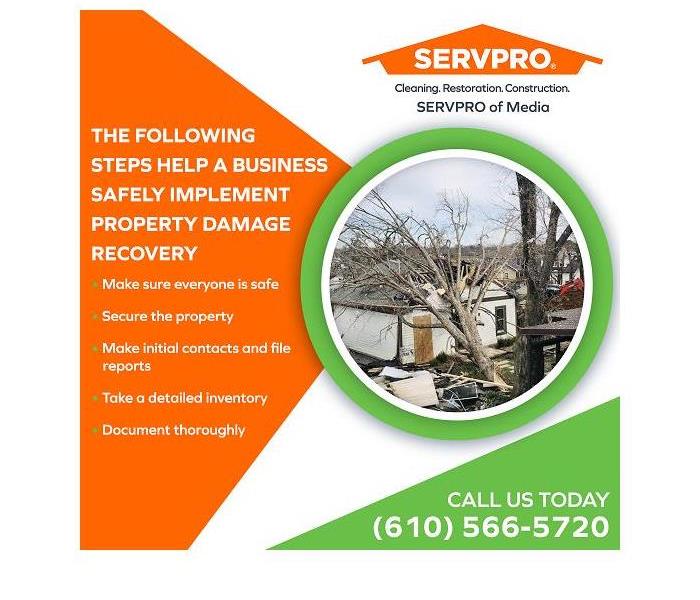Helping Media, PA, Businesses Recover from a Property Damage Disaster
8/11/2022 (Permalink)
Blog Summary: SERVPRO of Media highlights the steps a business must take to safely respond to and recover from fire, water, storm, or flood damage.
SERVPRO of Media outlines steps to assist businesses in safely responding to and recovering from a commercial property damage disaster. Business owners, management, and employees experience a range of emotions in the midst of the chaos and confusion. An initial shock is accompanied by uncertainty, helplessness, and grief before the damage is inspected and assessed.
When a business faces a property damage disaster, a clear path forward is important for the success of the business and the morale and confidence of the staff. An accurate property damage assessment and a rapid response are crucial if the business is to survive the crisis. The following steps help a business safely implement property damage recovery.
- Make sure everyone is safe.
- Secure the property.
- Make initial contacts and file reports.
- Take a detailed inventory.
- Document thoroughly.
Step #1: Ensure the safety of employees, onsite vendors, and any visitors that might be on the premises.
First, make sure that everyone is safe and stays safe. If a fire, severe weather, or chemical spill has rendered portions of the building unsafe, confirm that all personnel, including visitors, have evacuated the facility and made it to a safe location. A Readiness Plan will include evacuation routes, central meeting locations, and a check-in protocol to verify the building is clear. Assess any injuries, including emotional trauma. Provide initial first aid and any assistance that might be needed to stabilize immediate needs until first responders and other emergency personnel arrive.
The temptation is to re-enter the facility to recover personal items or important business documentation, account for missing persons, or begin the recovery process. No unauthorized personnel should be allowed back into the building until emergency officials give approval.
Step #2: Secure the location and equipment.
Once the damage scene is safe, take steps to protect equipment, documents, and inventory from further damage. Tarp or shield equipment and other valuable property. Relocate what items can be safely moved to protected and undamaged areas of the building. If structural damage has been catastrophic, relocate machinery, raw materials, and inventory to a safe, secure location. To ensure continuity of coverage, notify all insurers of changes in the status and location of all items. Avoid any unnecessary exposure to further financial loss.
If circumstances permit, implement emergency repairs to prevent damage from the elements, including severe weather. Board up the property to avoid trespassing or theft. Carefully clean up damage and debris to make the facility safe. Inspect the security system for functionality and use it even if the facility has been shut down and evacuated.
Step #3: Make first contacts and file initial reports.
Set aside time to inform the insurance company that a property damage incident has occurred and that a loss claim will be filed. The insurer will clarify if a police report regarding the incident is needed. Cases of vandalism, theft, or arson would be instances where a copy of this report might be requested.
During these initial contacts and reports, take detailed notes of all activities, including date, times, contact information, and a brief summary of conversations. Highlight action steps and follow-up. Loss reports are crucial for reimbursement and replacement payouts from the insurance company. Images and videos of the damaged property are essential. Review the security footage of when the damage occurred. Back the files up and save them on the cloud, where they are safe from corruption or deletion and can be easily accessed by third parties if needed.
Step #4: Take inventory of the damage.
Make a detailed list of equipment, machinery, raw materials, inventory, and any other items that might be covered under the policy. Separate damaged items from undamaged items. Do not discard or destroy items that seem beyond salvaging. If a salvageable item is discarded, the insurance company may not provide replacement value if the decision was made without consulting the insurer.
Step #5: Document, document, document!
Documentation should be thorough, detailed, and accurate when reporting the remaining equipment and inventory. Precise quantities and verifiable costs of equipment and goods are helpful to include in the document. Any reports or filings should be duplicated in hard copy and digital format and then stored offsite or on the cloud for safekeeping. Receipts, bills, invoices, orders, payments, and other documentation related to the commercial property should be retained and put in safe, accessible storage.
The benefits of working with SERVPRO of Media
When disaster strikes a business, every day lost to cleanup, restoration, and recovery translates into lost business, lost customers, employee migration, and possibly inventory degradation. SERVPRO arrives on-scene, inspects and assesses the damage, and provides the customer with a detailed, documented estimate. The cleanup and restoration process begins immediately because insurance companies and customers trust the professionals at SERVPRO. By bringing SERVPRO into the recovery and damage restoration process, a business can be confident that cleanup and restoration will be quick, allowing a swifter return to normal business operations.
For more details about commercial water damage restoration in Newtown Square, PA, contact SERVPRO of Media by calling (610) 566-5720. The office can also be reached by emailing office@SERVPROmedia.com






 24/7 Emergency Service
24/7 Emergency Service
